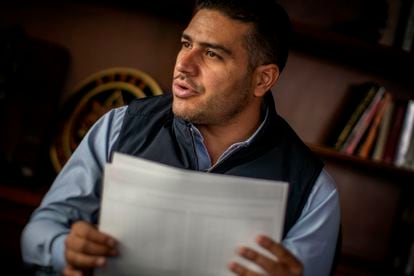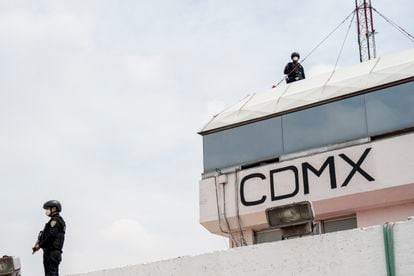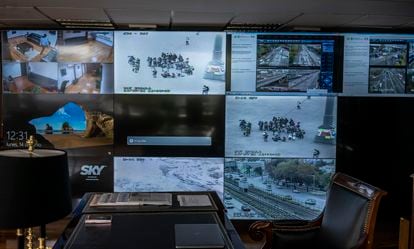Omar García Harfuch, the Mexican police chief who survived being shot at 414 times
The head of security and citizen protection in Mexico City gave EL PAÍS details of the brutal attack that killed his bodyguards and sent him to the hospital a year ago
/cloudfront-eu-central-1.images.arcpublishing.com/prisa/CB4YOILGRVBAJMD5VNRWNXBFKE.jpg)

The first thing Omar García Harfuch sees when he wakes up is a bookshelf where two photos take pride of place: portraits of his deceased bodyguards Edgar and Rafael. Aside from this human touch, his bedroom is sparse: a closet where several shirts and jackets hang arranged by color, and a TV he watches from bed (last night he stayed up late to catch up on Peaky Blinders). It doesn’t feel much like home, precisely because it is not. Harfuch has lived in his office building for the last year, ever since the day the Jalisco New Generation Cartel (CJNG) fired on him more than 400 times using assault rifles and grenade launchers.
The attack on his car as he drove through a leafy neighborhood lasted three minutes, and although he escaped alive, Edgar and Rafael were not so lucky. Today, two loaded pistols are the only items on Harfuch’s bedside table. After waking, the police chief opens WhatsApp on his phone. Every morning he receives a summary of the previous day of policing in Mexico City. At 5:30am, he is already exchanging messages, and an hour later, he will explain it all to Mexico City’s head of government, Claudia Sheinbaum. “This is not a police officer cowering or taking refuge in his office,” he says. “We are more active and more motivated than ever to reduce crime.”
But the attack has radically altered his existence. “Obviously, I have reduced how much I move around, I cannot see my daughters, my social life has been reduced to zero and I no longer go out on operations,” he admits. “The issue that obsesses me every day is not to finish off those who tried to kill me but to lower the crime rate.” The only signs of disorder on the office table are papers with charts pertaining to homicide data, robberies, arrests and vehicle theft. A third gun is carefully stowed away before our photographer has time to focus. “It wasn’t hard to get over the attack. I’m alive and my responsibility is to move on. I tell you that I went back to work with more drive than ever,” says Harfuch.

Thursday, May 20 at 9am. Omar Hamid García Harfuch was born 39 years ago in Cuernavaca (Morelos state). He is impeccably dressed, and it’s impossible to photograph him sweating or flexing in the gym. He was appointed Mexico City’s Secretary of Public Security in October 2019 and he knows exactly how to be seen behaving under the austerity protocols set by Sheinbaum. The most recent photo he uploaded to Instagram is of a sunrise from his office, taken from the eighth floor of the building overlooking Mexico City’s Torre Latinoamericana and the domes of the cathedral in the main city square. He looks out over a metropolis of 10 million inhabitants and an entrenched crime problem.
Today the headlines are screaming about police corruption, and an arrest warrant listing 57 officers. “Most of the 90,000 police officers in this city do a heroic and dignified job, but there are some corrupt elements who engage in extortion and collaborate with organized crime, and they dirty the work that thousands of other officers do every day. We are cleaning up the police and we are removing them, step by step,” he says confidently.
Some say he should be on that list. Harfuch’s name once appeared in the notebook of Sidronio Casarrubias, leader of the Guerreros Unidos cartel, alongside an alleged payoff of $200,000. The criminal outfit was blamed for the September 2014 disappearance of 43 trainee teachers from the Ayotzinapa Rural Teachers’ College in the southern state of Guerrero, a crime that deeply shocked Mexico. “Of all the things that have been said about me, the Ayotzinapa affair is what hurts me the most. Not only is it nonsensical and unjust, but it is one of the most painful episodes in Mexico’s recent history,” says Harfuch when questioned on this issue. “No good person ever wants to have their name associated with that place.”
There are hundreds of witnesses who can prove that he was not even stationed in Guerrero at the time. “These are the desperate claims of a criminal trying to save himself,” he adds. Then there was the accusation made by journalist Anabel Hernández that he had corresponded by letter with Mexico’s former security chief Genaro García Luna, who is currently on trial in the United States on drug-related charges. Harfuch explains that he only ever saw the disgraced figure once at an airport, accompanied by a mutual acquaintance. Their story ended there, he emphasizes. “You think I, a mid-ranking officer, am going to start writing letters to him? I have never written a letter in my life, not even to my own mother.”

Monday, June 4. Harfuch cancels his appointment for hand surgery. When narrating what happened during the attack, Harfuch doesn’t mince his words. He openly recalls glass shards raining down, and seeing his dead colleagues next to him. These are the facts: on June 28, 2020, around 50 hitmen from the Jalisco New Generation Cartel tried to kill him. Twenty of them approached his vehicle, leaving his car completely riddled with bullet holes, while 30 more were scattered across the city. A year on, 25 people have been arrested and 80 bank accounts frozen in connection with the crime. Among those detained was José Armando “El Vaca” Briseño, the cartel’s top assassin and the right-hand man of Nemesio Oseguera Cervantes, alias “El Mencho,” its leader.
His account of the attack is terrifying, but told matter-of-factly. “It was 6:32am and I was in the passenger seat checking some paperwork when I saw a truck cross in front of us. At that moment I knew we had been ambushed. Then I felt the first shot come through the windscreen. I pulled out my gun and fired back, and from that moment the shots rained down. It was deafening. I crawled into the back and crouched down, and waited for it all to end. Edgar and Rafa were already dead, glass was falling everywhere and there was a lot of dust. I had already taken a third shot, to the leg. After a few minutes that felt like an eternity, everything went quiet and someone knocked on the window, and said ‘get out, get out’. I didn’t want to open the door because I thought they were waiting to finish me off. Then someone said: ‘Tiger, Tiger, we’re here.’ That was my police nickname, so only someone who knew me well would call me that, and so I opened the door,” he recalls.
He took a colleague’s walkie-talkie and coolly radioed in the attempt on his life. Giving precise information on the location and size of the attack, he called for reinforcements. “I was wounded but calm. I had experienced shootouts before, though I had never been hit. It is clear to me that I was saved by the speed of the patrols arriving, because if they had taken 30 seconds longer, at a rate of 150 shots per minute, they probably would have hit me in some vital organ,” he explains.

He was taken to hospital on a stretcher, and learned that immediately after the attack 12 people had been arrested at the scene. Most of them confessed to working for the Tepito cartel, not CJNG. He dictated a tweet to present his own version of events : “This morning we were cowardly attacked by the CJNG. Two colleagues and friends of mine lost their lives, I have three bullet wounds and several cuts. Our nation must continue to confront cowardly organized crime. We will continue working.” It was 9:32am and the attack was recent enough that a media narrative had not yet been established. “The hitmen are trained to try and impose an alternative theory. They wanted that version to reach the media, but for several months we had detected the presence of the Jalisco cartel in the city and I was obsessed with stopping that version from spreading as soon as possible. I don’t think I acted hastily, as it was very clear to me that El Mencho was behind this,” he explains.
The attack revealed how much El Mencho, the most wanted man in the country, wanted him dead. During his time as head of operations of the Federal Police, the Jalisco New Generation Cartel lost several men and several more were imprisoned. Harfuch would be signed off work for three months. Is he aware that his life will never be the same? “The worst thing for me to bear is how it damages my family, but it would be selfish not to give my all given that I have a responsibility to millions of people. Sometimes the most important mission involves sacrificing your own family. The day I can’t stand it anymore or I don’t want to give it all I’m leaving.”
Friday, June 11 at noon. Harfuch grabs a taco without spilling a drop and knows how to fight for it with the rest of the agents jostling for food from a polystyrene tray. It’s Friday in mid-June and Harfuch makes one of his few weekly outings to award medals to a group of officers. About 20 people are required to do this. When he arrives, 10 uniformed men stand on the rooftops and another 10 bodyguards and police move in two armored vans that boast a special opening so they can fire from inside in case of attack.

”I miss the street and being there when things happen, but this is my place now,” he says. “For many years I have heard my colleagues say that they hold us back on this or limit us from doing that in our jobs, but now it is my responsibility to propose the legal and operational reforms that will allow us to investigate and expedite our police work: search warrants, phone tap authorizations, searches” he says, taco in hand. A 28-year veteran of the force says the difference between Harfuch and previous chiefs is that he is a true policeman. “He knows our shortcomings, the way we feel out here, the tactics, the strategy, when he’s being lied to or when he’s not,” he says. “He’s a good guy. He’s the type who will ask you how the family is doing or if you went on vacation. When I had Covid a few months ago he called me every day.”
The current Mexico City police chief is the grandson of General Marcelino García Barragán, a young revolutionary who rose to become governor of Jalisco state in the 1940s and was Defense Secretary during the Díaz Ordaz administration (1964-1970). His son Javier García Paniagua’s name has been linked to the Tlatelolco massacre of October 2, 1968. Harfuch’s boss, Mayor Sheinbaum, is the daughter of parents involved in the leftist movement and has mentioned on more than one occasion the times she went hand in hand with her mother to Lecumberri to visit prisoners. Harfuch’s father was president of Mexico’s Institutional Revolutionary Party (PRI) and his mother is the actress María Sorté, a star of several successful soap operas and a movie, El Barrendero, which she filmed while pregnant with Mexico City’s current police chief.
Harfuch grew up in the elegant Herradura neighborhood of the Mexican capital. He obtained a law degree from the Universidad del Valle de México. In 2008 he joined the Federal Police at age 26, and was stationed in Tamaulipas, Guerrero and Michoacán, while taking courses at Harvard and the Drug Enforcement Administration in Virginia. From his time in the federal police he learned the discipline and camaraderie required in a Tamaulipas barracks during the bloodiest years of the Calderón era, between 2006 and 2012. The Zeta and Sinaloa cartels were at the height of their killing and kidnapping sprees. In 2016, at 35, he joined the Criminal Investigation Agency of the former Attorney General’s Office, where he stood out as clever and eager guy. These days everyone asks if he wants to become Secretary of Federal Security, Mexico’s top security job, to which he always responds, “I want to continue working with Dr Sheinbaum.”

Wednesday, June 15 at 11am. Four corpses have appeared in the Gustavo A. Madero area of the city and this hits his numbers. Two days had passed with zero homicides, and these murders will require an explanation. “A stolen cellphone in La Condesa [a rich neighborhood] causes a tremendous scandal compared to terrible situations in other parts of the city and those perceptions of insecurity are difficult to control and can only be reduced with a lot of work. We are now obsessed with the 20 most violent quadrants of the city,” he says, pointing to a map divided into colors and sections. “In the last few months we have achieved some days with zero homicides in the city,” he boasts.
Some people distrust official data showing that, on average, the city has gone from 5.8 deaths per day to the current 1.8. After almost two years in office, Harfuch has less trouble talking about his attack than convincing the capital’s battered population that things are getting better.
/cloudfront-eu-central-1.images.arcpublishing.com/prisa/K755J5RQRBANZPKQOPE3K4ILRE.jpg)
/cloudfront-eu-central-1.images.arcpublishing.com/prisa/QAPZFQ5LH5BVXOOHRD4K6D5ZEQ.jpg)










































